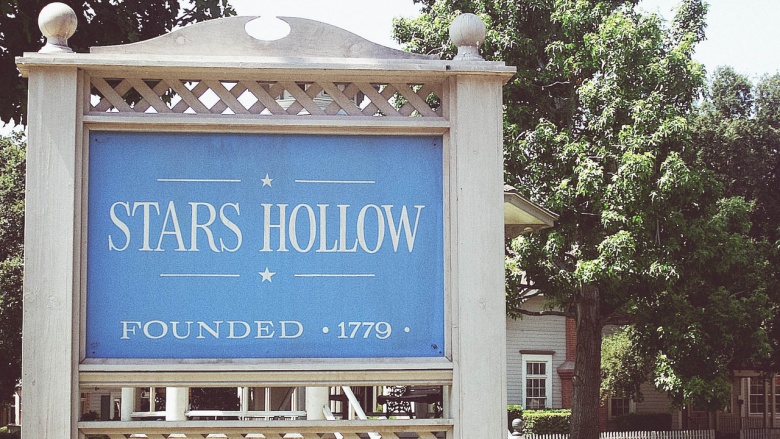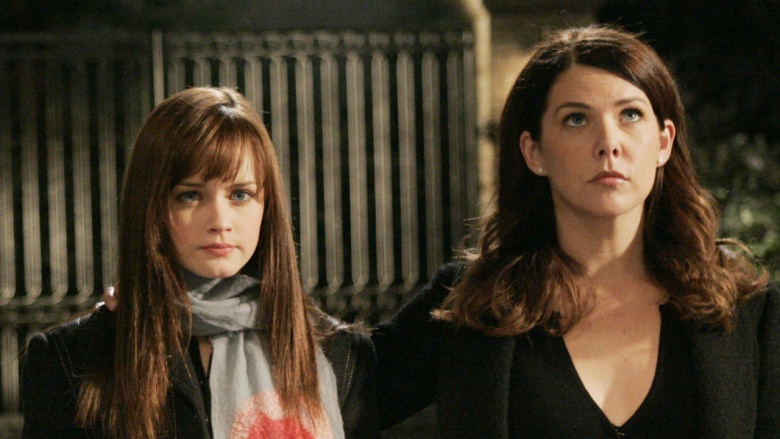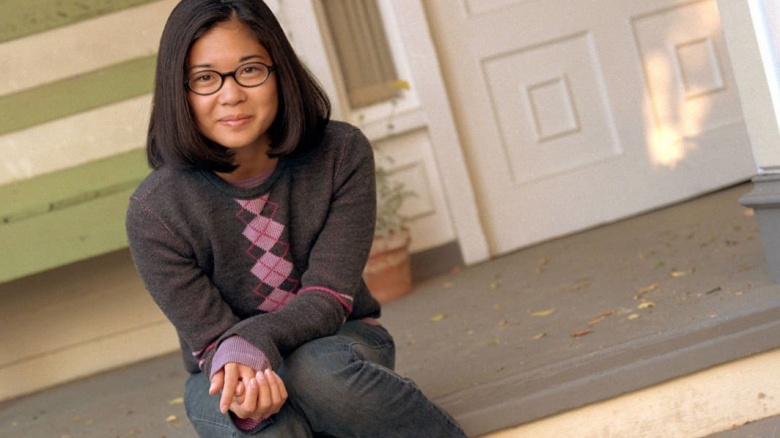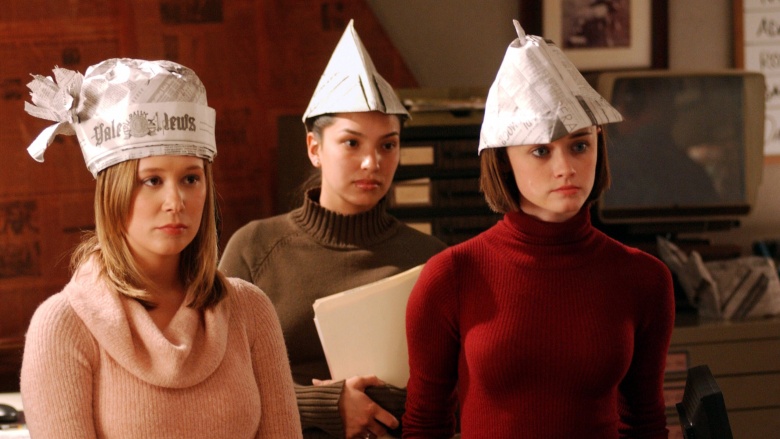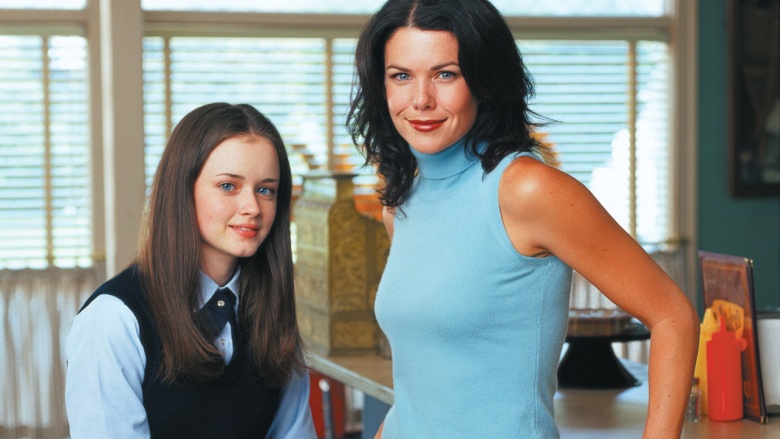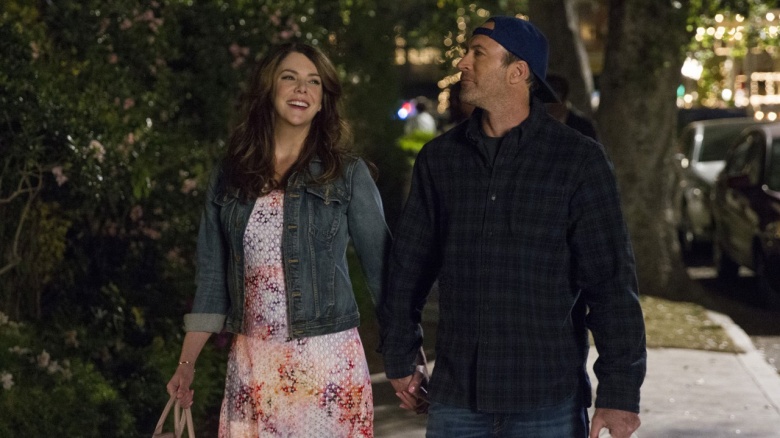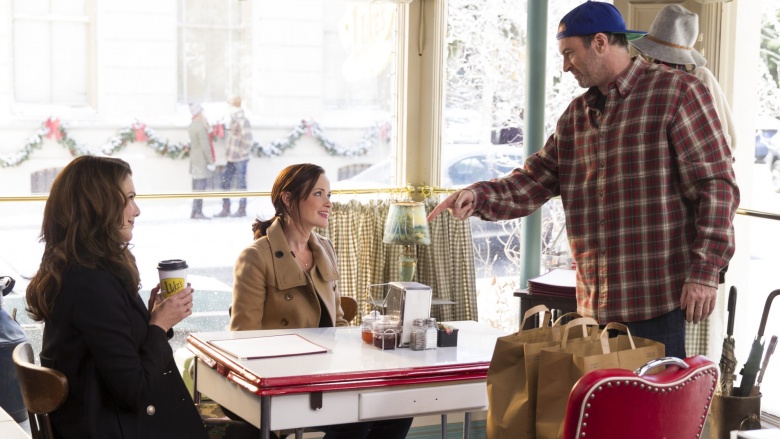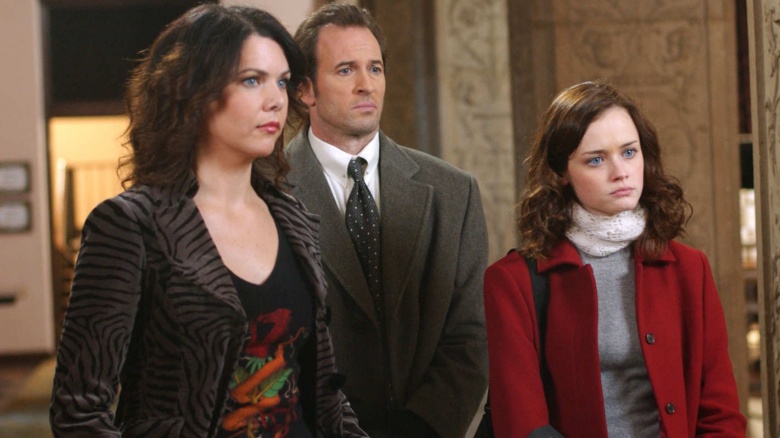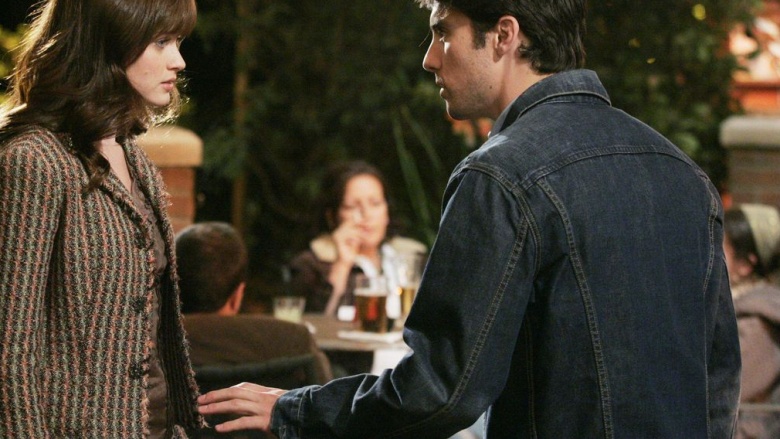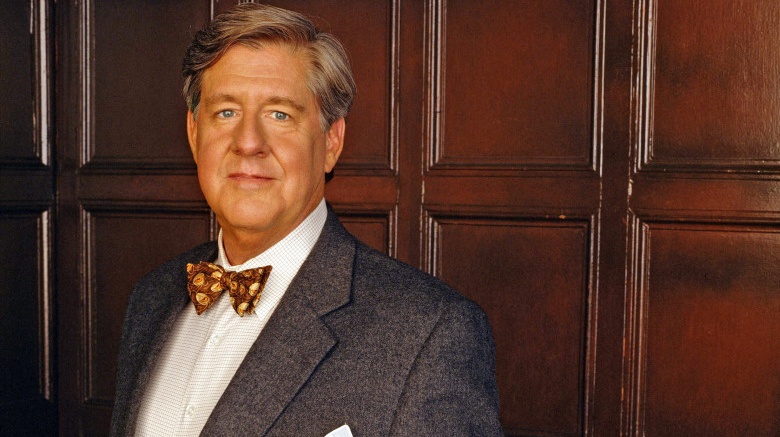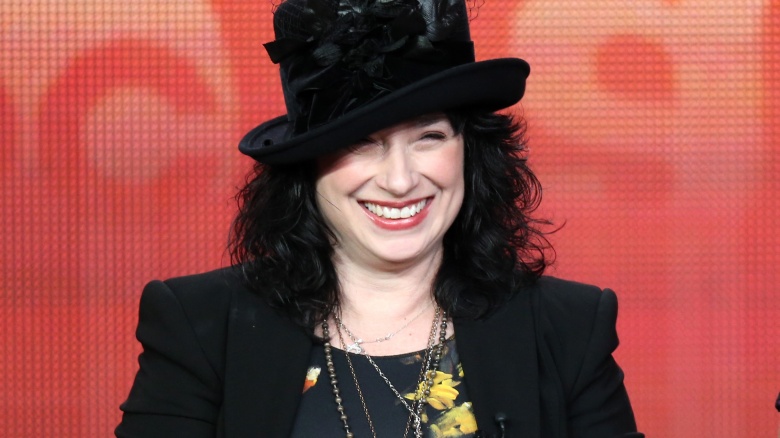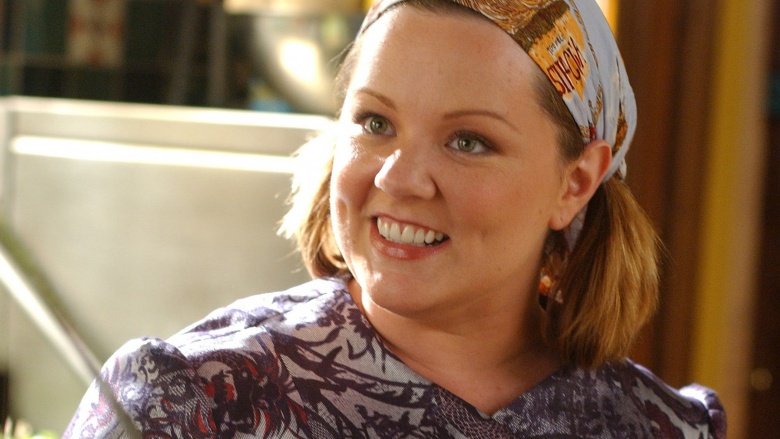The Untold Truth Of Gilmore Girls
That iconic blue welcome sign for Stars Hollow has finally come back into view thanks to Netflix's revival series, Gilmore Girls: A Year in the Life. The four-part film series serves as a follow-up to the whip-smart dramedy show, which championed the tagline "life's short, talk fast" during its seven season run.
Now, fans can expect to revisit Lorelai, Rory, Emily, Luke, Sookie, Jess, Logan, and the whole gaggle of townies that made its original run such a conversation piece. The behind-the-scenes history that went into making the show such a bingeable streaming sensation is nearly as rich as one of Taylor Doose's town tales, so here's a look back at the untold truth of Gilmore Girls.
Small-town inspiration
The show's creator and executive producer, Amy Sherman-Palladino, was inspired to create the beloved fictional small town within which the Gilmore girls grew up (Lorelai was still just a teen when she moved there with then-baby Rory, so that counts, too) by one of America's own honest to goodness little charmvilles. She told Deseret News that she and her husband, fellow producer Daniel Palladino, were inspired by a family trip through Washington, Connecticut to visit Mark Twain's house in Hartford.
"We're driving by, and people are slowing down, saying, 'excuse me, where's the pumpkin patch?'" Sherman-Palladino remembered. "And everything is green and people are out, and they're talking, and we went to a diner and everyone knew each other and someone got up and they walked behind the [counter] and got their own coffee because the waitress was busy. And I'm like, 'is this out of central casting? Who staged this for me?'"
If this scene sounds exquisitely familiar, that's because it is. Sherman-Palladino knew she'd struck creative gold and borrowed much of the town's set-up (how many times did Lorelai help herself to the coffee pot at Luke's Diner?) and even dialogue to come up with her early concept for the show. "If I can make people feel this much of what I felt walking around this fairy town, I thought that would be wonderful,' she explained. "It was beautiful, it was magical, and it was [a] feeling of warmth and small-town camaraderie."
Sherman-Palladino also told Entertainment Weekly that the name of Stars Hollow was a nod to Mia Farrow's estate in Connecticut called "Frog Hollow," which she and her husband visited while staying at a nearby inn which would eventually inspire the Independence Inn.
Theme song switcheroo
There are two very different versions of Carole King's "Where You Lead" available for your listening pleasure. The first, which she co-wrote in 1970 with Toni Stern, was a romantic ode that the legend herself later recanted because of its lyrical message of a woman following her man, despite her own interests and direction in life. "It came out before women's lib, and it's got kind of a 'stand by your man' lyric," she told the crowd at London's Hyde Park in 2016, as she performed the rest of her 1971 album Tapestry, in which the original number appeared.
King famously refused to perform the track live during her Tapestry concerts, but Gilmore Girls gave her an opportunity to the turn the song into something entirely different: a love song for the mother-daughter bond she shared with her own daughter, Louise Goffin, instead of a romantic ballad.
As Sherman-Palladino told EW, "We were just looking for something that felt classic and you just don't get more classic than Carole King—there's just nobody better. It was a song about connection and it was a song about where you lead, I'll follow – that we'll always be together."
Palladino thought it was a shot in the dark that they might get the rights to play the song in the intro, but then King offered something even better for the show and herself. "We got to her and what was weird is she said, 'I don't do that song anymore in concert because it's about a woman following a man and I feel that the times are different and I don't want to be singing about a woman following a man. But I love the idea of a mother and a daughter and if I could re-record it with my daughter and turn this song that I wrote into something more relevant, I would love to do that.'" And love it she does because now she can and does perform the modern version alongside the rest of her Tapestry tracks.
Art imitating life
Like a lot of popular series, the show's got some deep roots in reality. Not only are multiple settings based on the showrunner's dreamy small-town adventures, but some of the characters stemmed from real people as well. Actress Keiko Agena's character Lane Kim was based on writer-producer Helen Pai, who is best friends with Sherman-Palladino and did some script supervision on the show before co-authoring the novel version of the Gilmore Girls, titled The Other Side of Summer, in 2002. Lane's band, Hep Alien, is an anagram homage to Pai's name. Her husband, Dave Rygalski, was even the primary inspiration for the character who shared his name on the show (played by eventual star of The O.C., Adam Brody).
Meanwhile, the guy who played trembling Chilton-ite Brad Langford, actor Adam Wylie, really did star in Broadway's Into the Woods during his off-time from the show, which got written into his character arc.
Casting chaos
It's probably difficult for the Gilmore Girls faithful to imagine anyone else but Alexis Bledel as the ice-eyed, reluctant debutante Rory, but it's probably even more difficult to picture Liza Weil in the role. Weil, who played the snappy gunner Paris Geller, told BuzzFeed that she originally auditioned for the part of Rory but won something completely different in the process: Palladino designed the part of Paris specifically for her. "My fully formed self now sees it as a huge compliment that that's what they came up with from me reading originally for Rory," she explained. "Paris could just do anything. One I came to accept that, I had a great time."
Meanwhile, the sunny star chef Sookie St. James was supposed to originally be played by actress Alex Borstein, who got tied up with MadTV obligations. Sookie's love interest on the show, Jackson Belleville, was actually played by Borstein's own husband, Jackson Douglas. Melissa McCarthy eventually stepped into her chef's coat—although Sherman-Palladino said it was a "tricky sell" to get her the role—and Alex Borstein instead appeared in bit roles throughout the series, including the razor-tongued harpist Drella and Emily Gilmore's eccentric stylist Miss Celine.
The new kid
Before she landed the role of Lorelai Gilmore, Lauren Graham had gobs of small-screen experience, but Bledel was completely new to the acting business when she auditioned for and won the role of Rory. In fact, she'd only decided to become an actress a few months before the show was picked up, as she was still just a 20-year-old student at New York University. "I never thought they would hire me, because it seemed ridiculous to hire somebody who had never done any acting before," she told Entertainment Weekly.
Much like their mother-daughter bonding on-screen, though, Graham took it upon herself to guide her pretend daughter through the experience like any good mock mom would. "There was so much to take in, and then the lines. The camerawork on that show is very specific and we really had to hit certain marks, which especially when you start out, is just a foreign concept," Graham told E! Online. "I remember a lot of times just kind of grabbing her, just kind of leading her arm. So, in the beginning, people are like, 'You have such great chemistry.' And I'm like, 'I'm mauling her. That's why.'" That explains all the touchy-feely scenes from the early seasons!
Graham added to EW, "We have a lot of scenes in those early episodes where I'm literally gluing her to my side. I don't know if she noticed or cared, it kind of worked and it served to help make us look like this connected duo because I literally wouldn't let go of her."
Romantic rivalry
Graham was long rumored to have had a feud with Scott Patterson, who played her on-and-off leading love interest Luke Danes; some conspiracy theorists even alleged that Lorelai married Christopher instead of Luke because of Graham and Patterson's off-screen feud.
In a 2005 interview with TV Guide, Graham said that her relation with Patterson was "fine" and and that they "work well together" and had a "functioning, working set," but did admit that they weren't best friends with one another, either. (Another actress from Patterson's later show Aliens in America pegged him as "horrible" to work with, fanning the flames of the Gilmore feud.) Patterson himself echoed Graham's original sentiment, telling TV Guide that they had "a very comfortable working relationship" and that he "enjoyed doing scenes with her."
Putting almost a decade in between the end of season 7 and A Year in the Life must have done the pair good, though, because they were all smiles in his behind-the-scenes snapshot from the reboot series shoot.
That Gilmore gluttony
The gals were always so gung ho about their cups of joe that one might've believed the actresses playing them were as coffee-obsessed as their screen counterparts ... but there wasn't always java sloshing around in those mugs. In fact, Bledel didn't even drink coffee and had to substitute soda in her cups, while Graham had to sub alternative liquid options from time to time as well for safety's sake. She told Entertainment Weekly, "I drink a lot of coffee. I would get to this place on-set in real life where if I had anymore, I was going to keel over dead. So, sometimes there was water in there."
Home sweet home
If you feel like you've seen some of the Stars Hollow houses somewhere else before, you're probably right. ABC Family/Freeform's Pretty Little Liars uses the same WB set pieces as Gilmore Girls did, so a lot of properties—including Lorelai's house, Luke's Diner, Miss Patty's dance studio, and Kim's antiques—were transformed for that show and then some were used again for Grease: Live. PLL's use of the sets made them uninhabitable for the new Gilmore run because, as Sherman-Palladino told the TCA 2016 crowd (via Mashable), "they changed our Stars Hollow! They got a deal on brown paint! ... There was still the sidewalks we put in, they are cracked."
For A Year in the Life, though, the sets had to be completely rebuilt based on mere imagery from the show, and the cast and creatives seemed to be able to tell the difference, per their chat with Entertainment Weekly. For Patterson, Luke's Diner was "nicer" and "bigger" in revival form. Meanwhile, Kelly Bishop, who played the family matriarch Emily Gilmore, also found her faux home to be even more spacious than the last. "I was in the dining room and it's bigger. Because when you used to go by the dining room table there was the credenza by the side and it was a bit of a squeeze and there's no squeeze now," she explained.
Sequel squish
If you thought Jess Mariano's trip to California in season 3 seemed a little contrived—with him standing in his rebellious leatherwear in the sand and staring off into the Pacific—that's because it was. Milo Ventimiglia's character was actually all set to lead up a Jess-centric spin-off series surrounding his budding relationship with his father out west, and the GG episode which featured him first flitting off was meant to be a set-up for the new concept. According to the Palladino producer pair, though, it would've been much too expensive to go forth with their idea for Windward Circle, but Ventimiglia did film some portions of the would-be beach-set show.
There was also some talk of a Rory spin-off, too. As Graham remembered in a chat with TV Guide, she said goodbye after season 7, but the series' new producers showed an interest in keeping just Bledel for another 13-episode run. "I did formally say at one point, 'I'm not coming back.' Then they thought, 'Well, can we do it with just Alexis?' I don't want to speak for her, but we both went back and forth. Ultimately, neither of us wanted to do it without the other one," she remembered.
Bye, Grandpa
The death of actor Edward Herrmann in the off-time between Gilmore Girls' ending and the start of the revival was a somber one for the women who played his familial namesakes. And paying respect to his memory and that of his character Richard Gilmore was reportedly a very grounding experience for everyone involved. Graham told the TCA crowd (via Mashable) that Herrmann's death was "part of our story that we were telling. The journey of how everyone is sort of recovering. That gave the show a depth and emotional complexity that felt to me 'here's the show grown up even more.' I mention that because it plays into all the choices the characters are making."
Those four words
Sherman-Palladino and her husband exited their own show after six seasons due to friction with the network over contracts and creative provisions for their staff, so fans never got to see her original vision for the finale play out. She told Entertainment Weekly that she had an entirely different vision for the end than what fans got with the original Gilmore finale. "I wanted different things for Rory." Of course, at the time, Sherman-Palladino hadn't actually watched the seventh season, despite having a hand in selecting her replacement in David Rosenthal.
One thing that she definitely didn't get to finish was to end the show on those four words she always knew she'd close it up it with ... until now. But she's careful to warn that fans might be disappointed after so much hype. She told Vulture, "I feel like now I'll let people down because it's been so built up. 'Really? That's what we waited all these twelve years for? Well, thanks so much.'"
Indeed that was exactly Graham's reaction to hearing them herself while preparing for the revival series. She told Entertainment Weekly, "Amy didn't realize that I didn't know them, so we hadn't really talked about it. For some reason, my first question was, 'Who says them?' Because I assumed it was one character, when it's two. It's not as resolved as I thought they would be. I thought they would be 'Honey, I'm home!' or something like 'Goodbye, small town!' So I was like, 'Oh, really?'" Perhaps A Year in the Life will finally answer that long-lived question.
Melissa "Megabucks" McCarthy
While the news of Netflix's Gilmore Girls revival was exciting for everyone involved, one person who seemed to be snubbed on the invite list was McCarthy, whose Sookie was an icon of the original show but who has since gone on to become an A-lister in Hollywood. She told E! Online that she wasn't even invited to rejoin the show at first, despite Sherman-Palladino's suggestion that she was too busy for the new version. After that, Sherman-Palladino put an olive branch out by way of her Entertainment Weekly chat, saying, "There's nothing malicious going on. "We've just put it out into the universe; we're here until May 10. I know what the scene is. I'll pre-light it for her. She can drive up, run in, shoot it, and run out. I can get her in and out in two hours."
Given the swarm of familiar faces that joined the project by that point, the absence of Sookie would have been a pretty glaring omission, but the good news was that stars (hollow) aligned, and McCarthy's schedule eventually did clear up for her to do her bit. There were murmurs of co-star discontent over her hefty payday for the small cameo, but her on-screen BFF was certainly delighted.


